Vacationland by Camper Van
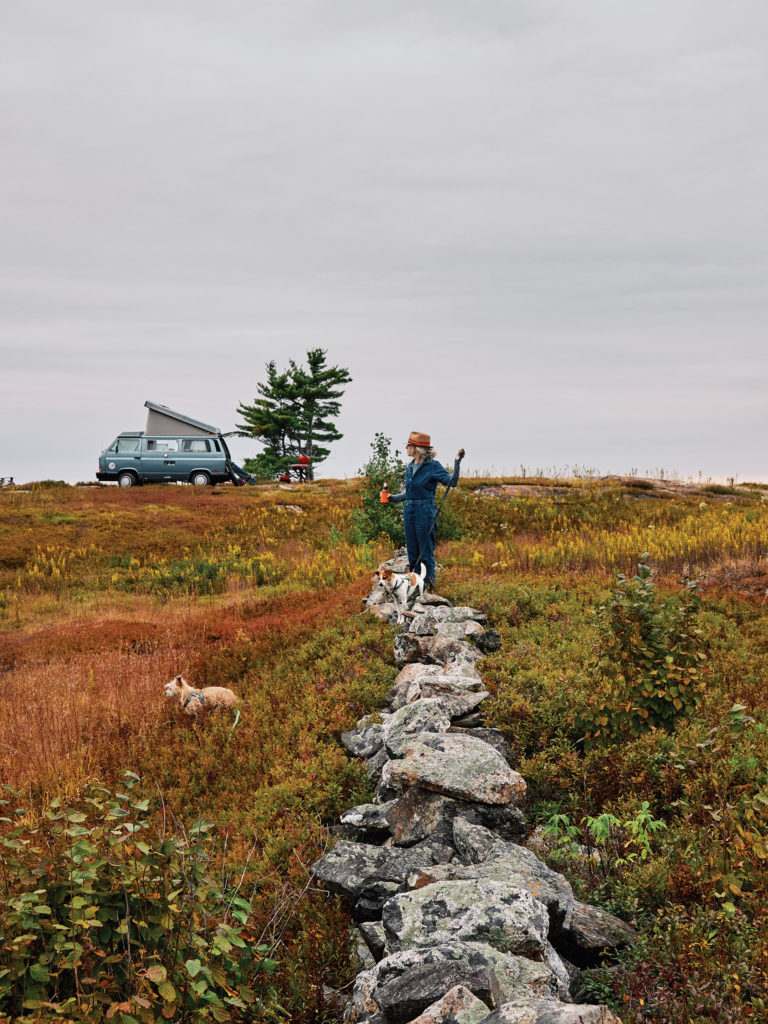
Vacationland by Camper Van
On an idyllic route from western mountains and lakes to blueberry hills and coastal islands, a vintage Volkswagen is the perfect companion.
By Sandy Lang
Photography by Peter Frank Edwards
Issue: May 2021
Behind a warehouse-sized office building with garage bay doors is where we first set eyes on Lupine, a vintage Volkswagen van with a paint color that reminds me of blueberries and a just-right shade of denim. We’ve wanted to try a different kind of outdoors-focused travel in these pandemic times and have been looking—with a mix of curiosity and pure envy—at all sorts of RVs and camper styles for months. When we spied this 1988 Volkswagen camper van available to rent online, we were ready to book.
Bob Muller, the owner of Vintage Van Adventures in Brunswick, explains that he’s been buying, restoring, and renting out a fleet of the iconic vans for years, and that Lupine is a favorite of his because of the authentic driving feel of the manual stick-shift operation. (He was excited to know we didn’t require automatic transmission, which he says is the more popular option.)
With my travel partner, photographer Peter Frank Edwards, I listen as Vintage Van Adventures employee Cole Hillis shows us the finer points of the more-spacious-than-you’d-think, German-designed interior: bench seating and table, a built-in sink, two-burner propane stove, several cabinets for storage, and a pop-up “upstairs” for sleeping. Simply squeeze two levers and push to raise the ceiling to an eight-foot height at the tallest end. There’s a lot to take in, but we’re eager to figure things out, and most features feel user-friendly and intuitive.
First Night, Rangeley

Windows, windows, windows. That’s the first thing you notice. In every direction we have nearly unobstructed views from our perches in the two bucket seats up front as we drive to our first destination, Rangeley Lake. (Handy fabric curtains may be pulled all the way around for privacy once parked at the campsite.)
With the engine in the rear, the front seats are very close to the front of the van. It’s like being in the driver’s seat of a bus, and we notice the sunny scenery even more than usual as we head northwest 100 or so miles on mostly two-lane roads. We slow down for better views at sites like the wooden bridge and picnic area around Coos Canyon on the Swift River off Route 17 and the scenic Height of Land overlook just before Rangeley. There, Peter Frank declares, “Now, this is motor-touring!”

No tent needed this trip: the 15-foot-long van has a pop-up sleeping loft. 
Getting happily sidetracked along the drive, this time at Swift River in Byron.
We luck out with an excellent campsite at Rangeley Lake State Park, even without a reservation. (Many Maine campgrounds reported extraordinary interest in reservations last season, so book early.) Circling through the campground before we park offers a mini-tour of other modes of camping: pup tents, standing-height tents, pull-behind travel trailers from Casita and Sportsmen Classic, the shiny curves of an Airstream, pop-up campers with the sides folded out, and a long and boxy Winnebago. At the two sites nearest ours, there are several beautiful wooden kayaks on top of the cars, and the campers we meet explain that they’ve come up from Portland to paddle for a few days. “It’s our first trip out of the city this year, and we’re loving it,” one of the women says.
Our spot for the night is tucked into the woods on a bend in the road, and has a direct footpath to the lake’s edge a few dozen yards away. (A tidy campground restroom is conveniently just two campsites away in the other direction.) As soon as we’re parked and have lifted the van’s slanted rooftop and set up a lantern on the table outside, I make a beeline down the path under the tall trees. Did I mention our scruffy little dog Felix is along? She can’t wait to get to the water either, and we rock hop until we are sitting on a massive boulder on the lake’s edge and watching for loons in the afternoon sunlight.
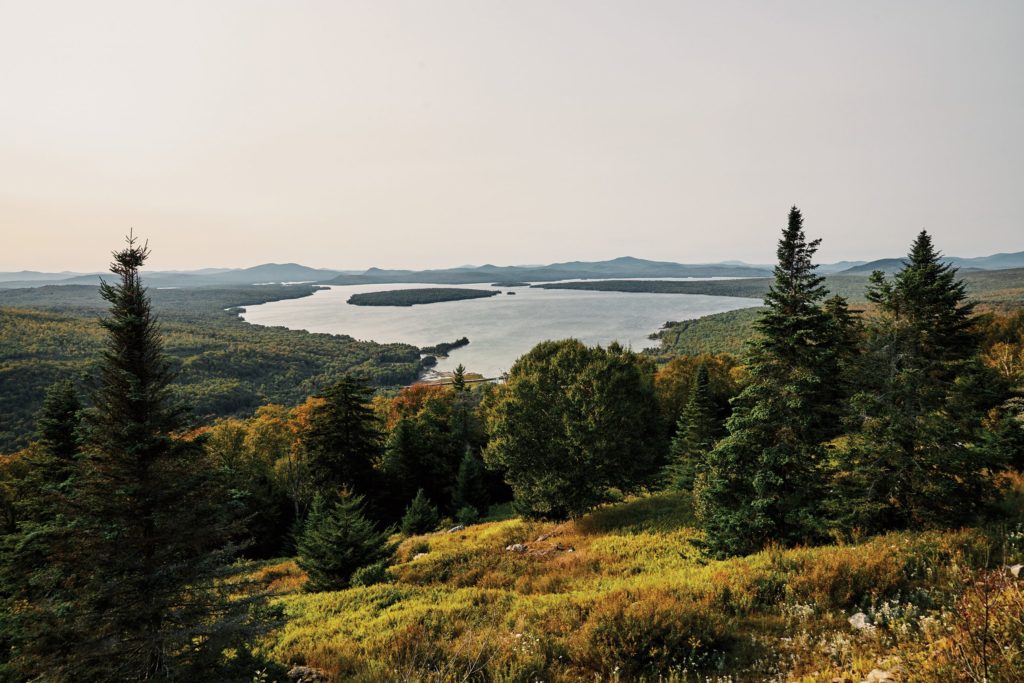
With the five-dollar bundle of firewood bought at the campground entrance, we soon start a fire in the fire ring and settle in. A perk after grilling chicken outside is being able to use the van’s kitchen sink to clean up with water from an onboard tank we’d filled earlier. And when we climb upstairs to sleep, I find that—made up with sheets and a down comforter—the thick cushion makes a terrific mattress, and the canvas sides of the raised top have screened windows to let in some of the cool night air. We sleep well in the quiet woods, waking up only when the chatter of squirrels starts in the morning, along with the whistle of wood thrushes.
To Blueberry Hill
Part camping, part road trip is how I’m seeing this getaway. After we pack up at Rangeley Lake, we stop for coffee in town at Inner Eye Coffee Shop and continue making roadside stops whenever we like. Handmade wooden chairs and picnic tables for sale in a front yard? Let’s stop and see how they sit. A farm stand with a jar to drop money inside? Let’s buy some tomatoes. When I see a well-worn straw fedora at Frost Antiques in Farmington, I have to have that, too.

For our second night, we don’t leave the campsite choice up to chance. We’ve made a reservation on Hipcamp, an online booking service with sites offered by private landowners (like VRBO or Airbnb, but with more rustic options for the camping set). I’m captivated by the idea of bringing our flower-blue Lupine to a blueberry barren, and we book such a site in Union. To get to the hilltop farm, we follow a rutted, rocky lane that disappears onto a flat rock ledge surrounded by blueberries. With only a firepit, wooden outdoor furniture, and views toward the Camden Hills, this is the stuff of camping dreams. We can see one farmhouse, but no other built features except the stone walls dividing parcels of the farm. It’s just past blueberry season, and the plants’ leaves are already turned to a burnished red—a gorgeous sight. The owner had mentioned that it’s fine to wander past the stone walls, and in season, guests may pick a few berries.
A windy afternoon and night, and the temperature’s dropping fast—such an exposed landscape is a good test for the comforts of the van—but we’re snug in the Westfalia, heating up water for cocoa after dark, then a pot of French press coffee in the morning. We go on a morning amble through the rolling blueberry fields, and the raw, damp day and scene have a look and feel like Scotland, I think. Maybe it’s the chilly gusts blowing through Felix’s reddish fur as she bounds through the low bushes. Meanwhile, a pair of hawks—northern harriers, we surmise—are riding the air currents and repeatedly swooping down, apparently hunting. Next time we’ll bring our binoculars and bird guide— and arrive in time for berry season.
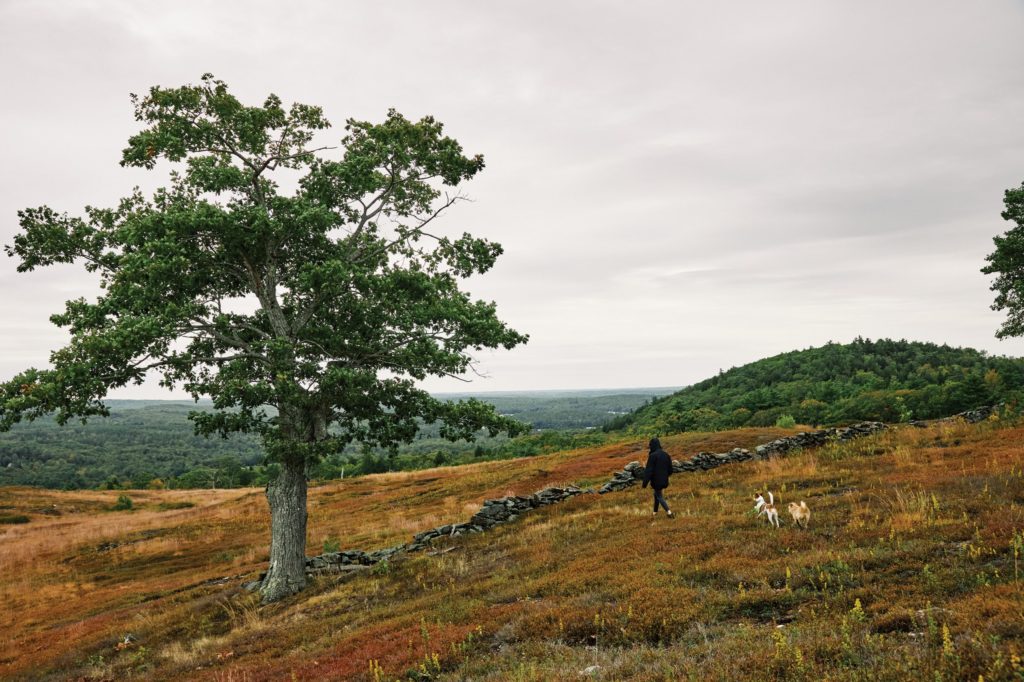
Woodsy, on the Isle
For our third night, we make our way to the Blue Hill Peninsula and drive toward the ocean. We booked a site at a private campground that’s just reopened after a many-years’ hiatus. The campground caretaker, Wolf, explains that the 12-campsite Four Acre Woods had sat unused since the 1990s before he helped a new owner to reopen the place in 2020. Wolf’s large dog—part European wolf, he says—sits near him as we talk a while about island living, saltwater swimming, and VW vans. He’s owned a similar van before, and our conversation reminds me of the friendliness of traveling this way. At a gas station, a couple waved and asked us the year of the van and where we’d been camping. It must be the personable look of the Lupine.
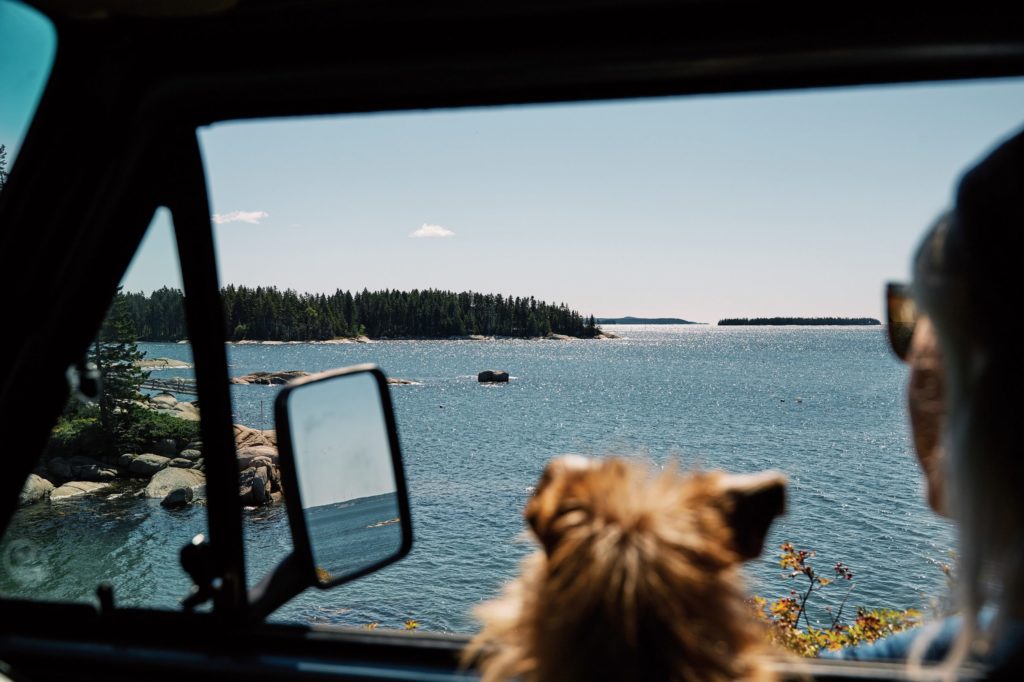
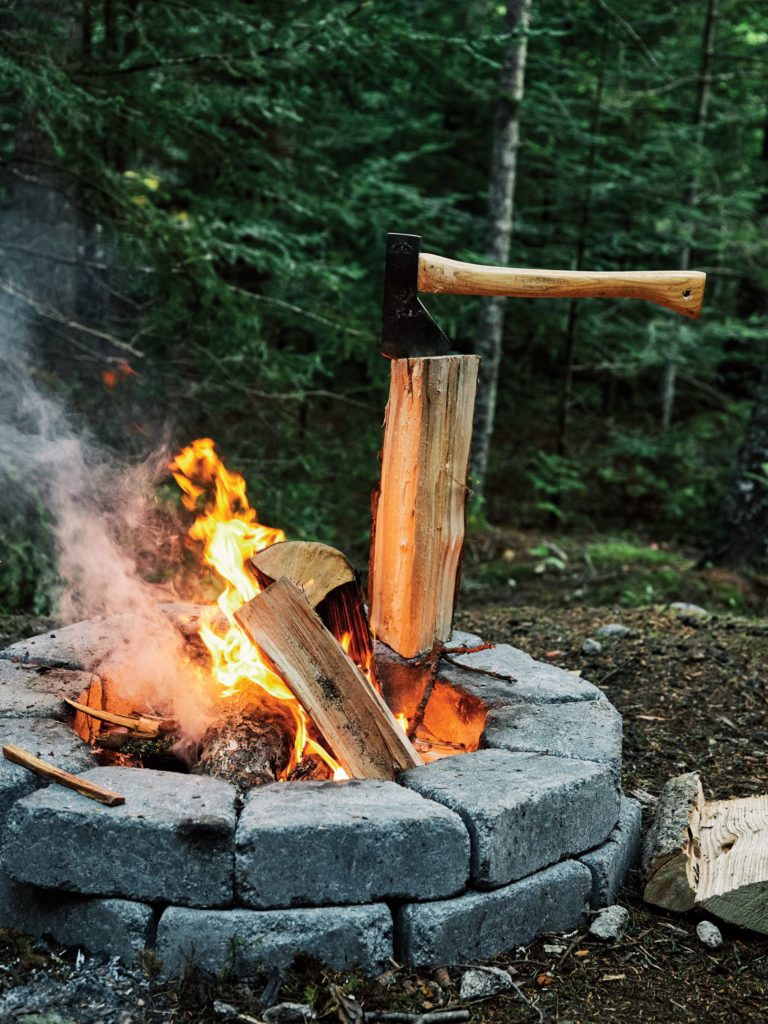
A campfire at Four Acres on Deer Isle. 
Our campsite on Deer Isle. 
Dinner with provisions from local farm stands cooked in the van’s kitchen and on the grill outside.
The revived Four Acre Woods campground is situated on just over four acres of tall birch, spruce, and fir on the off-the-beaten-path Sunshine Road section of Deer Isle, and it isn’t suited for large RVs or trailers. But since we’re traveling in one 15-foot-long vehicle, we fit just fine into one of the sites on the campground’s horseshoe-shaped drive with a communal bonfire area in the middle.
There’s electricity at each site, so for the first time on this trip, we unroll the extension cord and plug in to power the overhead lights and small refrigerator inside. Before we start a fire for grilling the hamburger we bought earlier, during a stop at the Lincolnville General Store, we walk to look for water views. After following a narrow road and a forest path, we find the woods open to a pocket of beach with a wall of granite rising on one end and the ocean ahead, a deep indigo blue. It’s a gush of sudden beauty.
The color blue has been with us all of the trip, I realize at that moment. And here it is again in all of its splendor. Lupine helped get us to places we hadn’t seen before, and experience the ease of camper life all the way from the mountains to the sea.
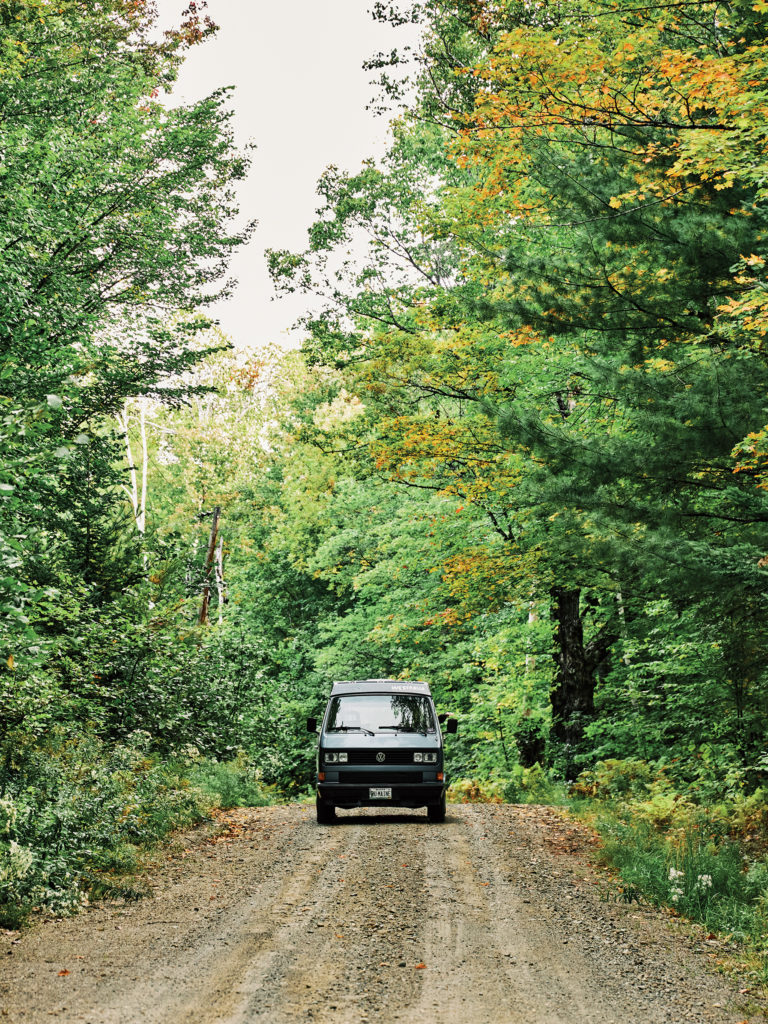
Late summer camping in Maine in a 1988 Volkswagen Westfalia Campmobile from Vintage Van Adventures. 
A sunset at Rangeley Lake on the trip’s first night.
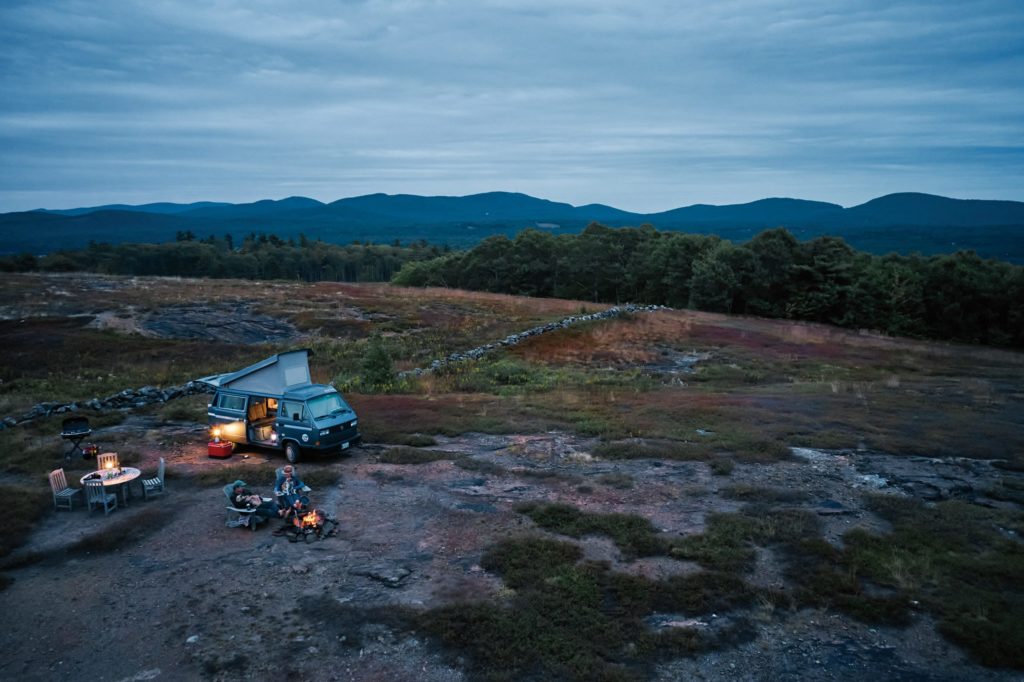
Camper Know-How:
Compared to tent camping, photographer Peter Frank Edwards and I found traveling by camper is similar in terms of food and logistics, but with the benefit of less concern about weather and fewer items to pack, since your shelter is driving along with you. These are a few lessons we learned about booking, packing, and cooking when you’re in RV mode:
Campground reservations are a hot ticket in Maine.
Plan ahead, especially if you’re looking for water, electricity, or sewer hook-ups. For most parks and private campgrounds, bookings can be made online. Campgrounds at Acadia National Park were closed for the 2020 season, but 2021 reservation details can be found at recreation.gov. Maine’s state park campgrounds span from the mountains and lakes to the coast, including a few of our favorites, Rangeley Lake State Park, Cobscook Bay State Park, and Lily Bay State Park, and can be booked online at campwithme.com. If plans change or you’re being spontaneous and don’t have a reservation, you can also try calling a state park or private campground for day-of openings or check other online booking sources like hipcamp.com to see what’s available for an overnight on private land.
Traveling with a partner helps.
It can take teamwork to set up a camper, open the awning, organize the gear, and keep things tidy as you go.
Enjoy the freedom of packing light!
Rental camper vans from Vintage Van Adventures (vintagevanadventures.com) are fully stocked with plates and cookware, bedding, an outdoor grill, a cooler, and other necessities, so you only truly need a few clothing options, including a raincoat to be safe, along with food, drink, and toiletries.
Everyone has their own must-haves.
We recommend bringing old-fashioned paper plates, so you’ll have fewer dishes to wash, and headlamps to find your way during any evening exploring or nighttime treks to the campground restroom, if your RV doesn’t have a toilet inside. (VW vans have sinks for handwashing and washing dishes, but no toilet.)
For camp cooking, bring a few favorite pantry items, and extra drinking water.
You might want instant oatmeal, coffee, and your must-have spices and condiments, then plan on shopping for local additions along the way. We stopped at roadside farm stands and the Lincolnville General Store for chicken for the grill, wine, tomatoes, salad greens, cheese, bread, and an early pumpkin for a table decoration.
Don’t move to a new campsite each day.
We stayed somewhere new each night, but it sounded good to us when we heard the veteran RV campers’ rule of a two-night or longer stay for the best chance to explore and relax. This summer, we’ll stretch out the camping trips!



